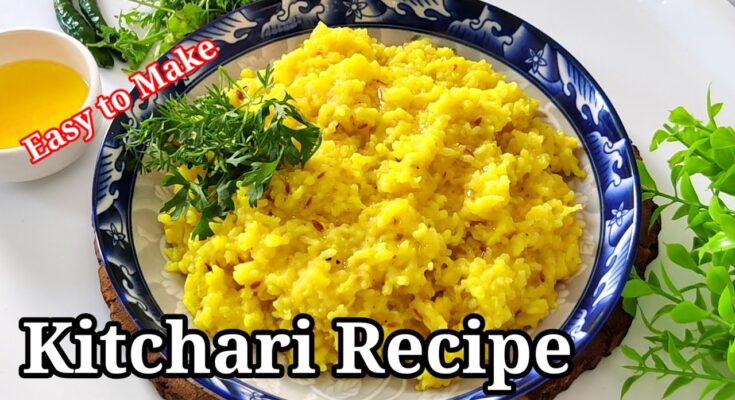Kitchari Recipe: Kitchari, often pronounced as “kich-ree,” is a classic Indian dish that brings together rice and lentils into a warm, comforting, and nourishing porridge. Often described as the chicken soup of Ayurveda, Kitchari is a staple in Indian homes, particularly during times of illness, detox, or simply when one craves something easy on the stomach. But don’t mistake its simplicity for blandness—Kitchari is aromatic, flavorful, and deeply satisfying.
This golden dish is more than just food; it’s a healing potion in a bowl. It’s known for balancing the body’s doshas—Vata, Pitta, and Kapha—making it a go-to for wellness retreats and Panchakarma cleanses. Whether you’re a health nut, a yoga enthusiast, or just someone looking for a fuss-free meal, Kitchari deserves a place in your culinary repertoire.
Why is Kitchari so popular in Ayurvedic cooking?
Ayurveda considers Kitchari a “sattvic” food, meaning it’s pure, balanced, and nourishing to the body and mind. Its popularity stems from its role as a complete meal—providing carbs from rice, protein from lentils, and digestive support from spices like cumin, turmeric, and ginger.
During Ayurvedic cleanses, Kitchari is often eaten exclusively for several days. This mono-diet helps to reset the digestive system, remove toxins (ama), and promote internal healing. It’s light enough to give the digestive tract a break, yet hearty enough to keep you energized.
If you’re looking to align with your body’s natural rhythm or simply enjoy a soulful meal, Kitchari is where wellness meets flavor.
Health Benefits of Kitchari
Detox and Cleansing
One of the most celebrated aspects of Kitchari is its detoxifying properties. In Ayurvedic medicine, Kitchari is used during Panchakarma treatments to clear the digestive tract of built-up toxins. Its ingredients are chosen for their ability to gently cleanse the body without depleting it of energy.
Turmeric fights inflammation and purifies the blood. Ginger improves digestion and metabolism. Cumin, mustard seeds, and asafoetida boost gut health and prevent bloating. Together, they transform Kitchari into a gut-healing superfood.
When eaten over a few days, Kitchari helps reset your palate, reduces cravings, and often leads to clearer skin and improved energy levels.
Easy on Digestion
Kitchari is designed to be kind to your gut. Split yellow mung dal, one of its key components, is one of the easiest legumes to digest. Paired with white basmati rice, which is light and quick to cook, it forms a porridge-like consistency that soothes the stomach.
Spices aren’t just for flavor—they’re medicinal. Asafoetida (hing) prevents gas, ginger enhances digestion, and turmeric reduces inflammation. If your stomach has been feeling off or you’re recovering from a stomach bug, Kitchari is your best friend.
It’s ideal for people with food sensitivities, leaky gut, or anyone on an elimination diet. Because it’s so simple, it allows your body to focus on healing rather than digesting complicated meals.
Nutrient-Dense and Balanced
Don’t let its humble look fool you—Kitchari is loaded with essential nutrients. It’s a complete protein when made with rice and dal. Add ghee, and you bring in healthy fats that help absorb fat-soluble vitamins. Add veggies like carrots, spinach, or zucchini, and you have a balanced, colorful dish packed with fiber, antioxidants, and vitamins.
This balance of carbs, protein, and fats provides sustained energy without spikes or crashes. Whether you’re trying to lose weight, manage blood sugar, or eat more whole foods, Kitchari delivers on all fronts.
Ingredients for a Traditional Kitchari
Core Ingredients
To make a classic Kitchari, you’ll need:
- 1/2 cup basmati rice
- 1/2 cup split yellow mung dal
- 1 tbsp ghee (clarified butter)
- 1 tsp cumin seeds
- 1/2 tsp mustard seeds
- 1/4 tsp asafoetida (hing)
- 1 tsp turmeric powder
- 1 tsp grated ginger
- 1/2 tsp salt (adjust to taste)
- 4 cups water
These ingredients are carefully chosen not just for flavor but for their Ayurvedic properties. Ghee soothes the digestive tract and enhances nutrient absorption. The dal and rice provide the protein-carb combo, while spices make the dish light and warming.
Optional Add-Ins for Variety
Want to jazz things up a bit? Try adding:
- Chopped vegetables like carrots, zucchini, spinach, or peas
- Fresh coriander or cilantro for garnish
- A squeeze of lemon juice for brightness
- Coconut flakes for a South Indian twist
- Black pepper for added warmth
Kitchari is wonderfully versatile. Depending on your mood or the season, you can adapt the recipe to make it more grounding, cooling, or energizing.
Step-by-Step Kitchari Recipe
Step 1: Rinse and Soak the Rice and Dal
Begin by thoroughly rinsing ½ cup of basmati rice and ½ cup of split yellow mung dal under cold water until the water runs clear. This process removes excess starch and any impurities. Soaking the rice and dal for about 15–20 minutes can aid in digestion and reduce cooking time.
Step 2: Prepare Your Spices
In a small bowl, gather the following spices:
- 1 teaspoon cumin seeds
- 1 teaspoon mustard seeds
- ½ teaspoon ground turmeric
- 1 teaspoon grated fresh ginger
- A pinch of asafoetida (hing)
- Salt to taste
These spices not only enhance flavor but also aid in digestion and have anti-inflammatory properties.
Step 3: Cook the Base
In a large pot, heat 1 tablespoon of ghee or coconut oil over medium heat. Once hot, add the cumin and mustard seeds. Sauté until they begin to pop, releasing their aromatic flavors. Add the grated ginger, turmeric, and asafoetida, stirring for another minute to combine the spices well.
Step 4: Add Rice, Dal, and Water
Drain the soaked rice and dal, then add them to the pot with the sautéed spices. Stir to coat the grains with the spice mixture. Pour in 4 cups of water and add salt to taste. Bring the mixture to a boil over high heat.
Step 5: Simmer Until Perfect
Once boiling, reduce the heat to low, cover the pot, and let it simmer for about 30 minutes. Stir occasionally to prevent sticking. The kitchari is done when the rice and dal are soft and the consistency is porridge-like. If it becomes too thick, add a bit more water to reach your desired consistency.
Step 6: Add Final Seasoning and Serve
Taste the kitchari and adjust the seasoning if necessary. For added freshness, garnish with chopped cilantro and a squeeze of lemon juice. Serve hot as a nourishing meal on its own or with a side of steamed vegetables.
Customizing Your Kitchari
Making It Seasonal
One of the beautiful aspects of Kitchari is how effortlessly it adapts to the changing seasons. In Ayurveda, aligning your diet with the seasons is key to maintaining balance and health. With Kitchari as your base, you can customize it to suit whatever time of year it is.
In spring, when your body naturally wants to detoxify and shed the heaviness of winter, you can add bitter greens like kale or spinach, and use lighter spices such as coriander and fennel. Swap out ghee for coconut oil to keep things refreshing.
Come summer, cooling vegetables like zucchini, asparagus, and green beans are excellent. Use cilantro generously, and reduce heating spices like ginger and mustard seeds. You can even serve it a little cooler than usual to help cool the body.
During fall and winter, you want your Kitchari to be more grounding and warming. Add root vegetables like sweet potatoes, carrots, and beets. Go heavier on the ghee and spices like ginger, cinnamon, and black pepper to ignite digestion and keep your internal fire strong.
The seasonal approach not only enhances flavor but also boosts the medicinal value of your meal, helping you stay in sync with nature.
Protein-Rich Variants
While traditional Kitchari already includes a balanced protein profile through rice and dal, you can easily give it a protein boost if you’re active, recovering, or trying to build muscle.
Here are a few ways to amp up the protein content:
- Quinoa instead of rice: Swap white basmati rice for quinoa. It’s a complete protein and still easy on the stomach.
- Add tofu or tempeh: Especially in vegan versions, cubed tofu can be stirred in during the last few minutes of cooking.
- Use different dals: Moong dal is gentle, but chana dal or red lentils offer a denser texture and more protein.
- Top with seeds: A sprinkle of hemp or pumpkin seeds before serving adds not just protein but a lovely crunch too.
Protein-rich Kitchari is perfect for post-workout meals, growing teens, or anyone who feels a bit more depleted and needs extra nourishment.
Serving Suggestions
Best Toppings and Side Dishes
While Kitchari is perfect on its own, it’s also a wonderful canvas for all kinds of toppings and side dishes. You can dress it up or keep it minimal depending on your mood and dietary needs.
Here are some of the best ways to serve it:
Toppings:
- Fresh cilantro or mint leaves
- A drizzle of ghee or coconut oil
- A squeeze of fresh lemon or lime
- Roasted cumin or fennel powder
- Toasted sesame seeds or shredded coconut
- Avocado slices for creamy texture
Side Dishes:
- Steamed or sautéed greens like spinach, kale, or bok choy
- A simple cucumber raita or vegan yogurt
- Pickled vegetables for a tangy punch
- Herbal teas like cumin-coriander-fennel or ginger tea to aid digestion
If you’re hosting a healing dinner or simply want to elevate your solo meal, adding a few of these elements creates a well-rounded Ayurvedic plate that feels both grounding and luxurious.
Tips for Perfect Kitchari Every Time
Let’s be honest: it’s easy to mess up simple dishes because we take them for granted. To make sure your Kitchari turns out perfect each time, keep these tried-and-true tips in mind:
- Soak the rice and dal – This cuts cooking time and enhances digestibility.
- Use fresh spices – Old spices lose their potency. Toast them gently to bring out their full flavor.
- Keep the texture in mind – Kitchari should be soft and porridge-like, not dry or too watery.
- Don’t skip the ghee – Unless you’re vegan, ghee adds both flavor and vital nourishment.
- Season at the right time – Add salt during cooking, but taste and adjust just before serving.
- Stay gentle with veggies – Don’t overcook them; they should retain some bite and color.
- Cook low and slow – Rushing leads to uneven cooking and bland flavor.
- Use high-quality ingredients – Organic rice, dal, and spices make a noticeable difference.
Making Kitchari is as much about intention as it is about ingredients. Stir it with love, serve it warm, and let it work its healing magic.
FAQs about Kitchari Recipe
Can I eat Kitchari every day?
Yes, you can. Many people enjoy Kitchari daily, especially during detox or healing phases. Since it’s easy on digestion and packed with balanced nutrition, it’s ideal for anyone needing a reset or a break from processed foods. Just remember to vary your vegetables and spices to keep it interesting and nutritionally rounded.
Is Kitchari suitable for weight loss?
Absolutely. Kitchari is low in calories, high in fiber, and very satisfying. It prevents overeating by keeping you full and nourished. Its detoxifying properties also help reduce bloating and water retention. Combine it with regular exercise and plenty of hydration for best results.
Can I make Kitchari in a pressure cooker or Instant Pot?
Yes, and it’s a great time-saver. Simply sauté the spices directly in the pot using the “Sauté” function, then add the soaked rice, dal, and water. Pressure cook for about 8–10 minutes, and let the pressure release naturally. You’ll get a perfectly creamy Kitchari with minimal effort.
What if I don’t have ghee?
No worries! While ghee adds flavor and digestive benefits, you can substitute with coconut oil, olive oil, or even avocado oil depending on your dietary preferences. For a nutty flavor, toasted sesame oil also works wonderfully, especially in winter.
How long does Kitchari last in the fridge?
Kitchari stays fresh for up to 3–4 days when stored in an airtight container in the refrigerator. You can reheat it on the stove or in the microwave. Add a splash of water or broth to bring it back to the right consistency. It also freezes well if you want to make it in bulk.
Conclusion
Its simplicity is what makes it so powerful. Just a few pantry staples, cooked slowly with intention and care, turn into a nutrient-dense dish packed with healing benefits. It’s easy to digest, rich in essential nutrients, and incredibly customizable to your personal health needs or taste preferences.
So next time you’re not sure what to eat, or when your body feels out of balance, consider making a pot of Kitchari. It’s a timeless recipe that supports wellness, one bowl at a time.



